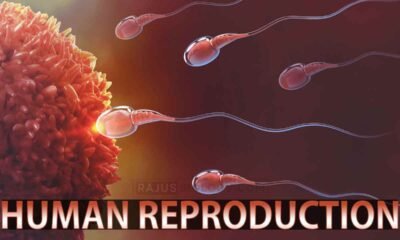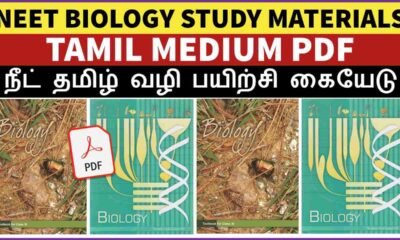Blog
Reptilia General Characteristics, Classification and Examples | Free Biology Notes

After reading this article you will learn about Reptilia General Characteristics, Classification and Examples
Reptilia General Characteristics
- They are basically terrestrial but some are aquatic
- Body is divided into 4 parts:- Head, neck, trunk and tail
- They are cold blooded animals or poikilotherm
- Limbs two pairs, five clawed digits in each limb (Some limbless)
- Skin dry, rough and non glandular. Endoskeleton is made up of epidermal scales or plates
- Alimentary canal terminates into cloaca
- Respiration only by lungs
- Heart is usually 3 chambered or partially four chambered (4 Chambered in crocodile)
- Brain developed, cranial nerves 12 pairs
- Ear in the form of tympanum
- Jacobson’s organ present in the roof of buccal cavity concerned with smell
- They are unisexual, oviparous, internal fertilisation.
- Development is direct. No metamorphosis and parental care found
Classification of Reptilia
The class Reptilia is differentiated into two major sub-classes: Anapsida and Diapsida
Subclass 1. Anapsida
- The dermal bones form a complete roof over the skull with no temporal fossae.
- These are sub-divided into Cotylosauria and Chelonia.
- Modern chelonians are classified according to the method of retracting the head in the shell.
- Turtles, tortoises, and terrapins belong to this group.
- These are include only one order – Chelonia
Order – Chelonia
- Terrestrial, marine and fresh water animals
- Body covered in two shell plates:- Dorsal shell – carapace and Ventral shell – Plastron
- Limbs clawed, webbed and paddle like
- Jaws horny beak like and no teeth
- All three organs can be withdrawn in carapace
- Cloacal aperture helps in respiration (Cloacal respiration)
- E.g., Che lone (turtle), Testudo (Tortoise), Trionyx (Terrapin)
Subclass 2. Diapsida
- There are two temporal vacuities in the skull.
- They are diverse of all reptiles.
- The dinosaurs and pterosaurs are included in this group.
- These are divided into three orders – Rhynchocephalia, Squamata and Crocodilia
Order 1. Rhynchocephalia
- Most of the species of this order are found in form of fossils
- Only sphenodon punctatum species is live (found in new Zealand only)
Order 2. Squamata
Squamata It includes two suborders:- Lacertilia and Ophidia
Suborder (1) Lacertilia
- Limbs will developed
- Eyelids movable
- Nictitating membrane found in eye
- Tympanum present
- E.g., Lizards, such as Chameleon (Tree lizard), Calotes (Garden lizard), Hemidactylus (wall lizard)
Suborder (2) Ophidia
- Limbs are absent
- Eye lids immovable
- Nictitating membrane absent
- Tympanum absent
- E.g., snakes, such as Naja (Cobra), Bungarus (Krait), Vipera (Viper).
Order 3. Crocodilia
- Freshwater animals found on land and water
- 4 chambered heart present
- Largest modern reptiles
- Skin is covered by bony plates
- Snout long
- E. g., Crocodilus (Crocodile), Alligator, Gavialis (“Gharial”).
Extinct Groups of Class Reptilia:
Following extinct groups of class reptilia are important to mention here.
i. Cotylosauria:
They were most primitive reptiles and closest to early amphibians. They were without temporal fossae in the skull, e.g., Seymouria.
ii. Ichthyopterygia:
They were fish-like and had single fossa in the skull e.g. Ichthyosaurus. ’
iii. Archosauria:
They had diapsid skulls. Some were bipedal and gave rise to birds. A group of Archosauria also gave rise to dinosaurs, e.g., Brontosaurus.
iv. Synaptosauria:
The skull had a single temporal fossa on either side. They were mammal-like reptiles that later on gave rise to mammals, e.g. Plesiosaurus.

 Entertainment1 month ago
Entertainment1 month agoIbomma Bappam: Redefines Telugu Streaming Trend

 Blog2 months ago
Blog2 months ago[PPT] The living world Class 11 Notes

 Blog2 months ago
Blog2 months ago[PPT] Human Reproduction Class 12 Notes

 Blog1 month ago
Blog1 month agoIosmirror.cc Apk: Enables Smart Screen Sharing
- Blog2 months ago
PG TRB Botany Study Material PDF Free Download
- Blog2 months ago
Class 12 Biology Notes Chapter wise PPT
- Blog2 months ago
Class 11 Biology Notes Chapter wise PPT

 Blog2 months ago
Blog2 months agoDownload NEET Biology Study Materials in Tamil












